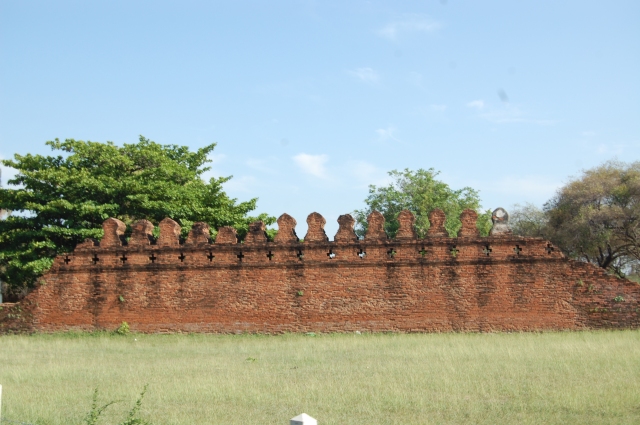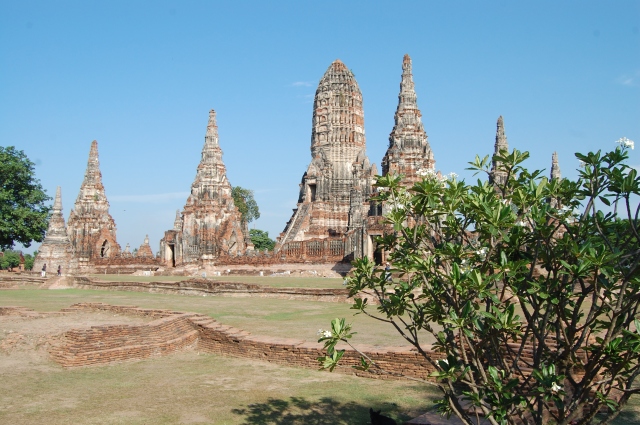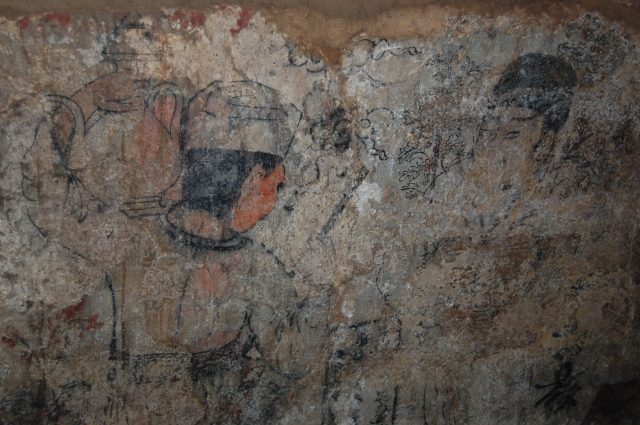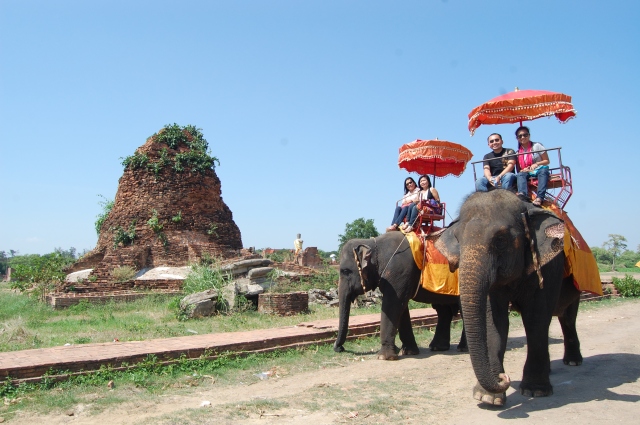The challenge posed by this site is to make sense of the scattered remains of a former strong Southeast Asian empire’s capital. Its complete name Phra Si Nakhon Ayutthaya only suggests the reverence and significance Thais generally identify with to this ancient city. The historic city of Ayutthaya gained global importance due to its strategic trading location and strong diplomatic networks that were highly prized by the Chinese, Indians, Japanese, Dutch, Portuguese, and even the British. Its inscription to the WH list, however, is anchored on criteria (iii): to bear a unique or at least exceptional testimony to a cultural tradition or to a civilization which is living or which has disappeared.

This is one of the few standing sections of the old walls that once acted as the line of defense of Ayutthaya. Present day Bangkok is largely patterned after this old city, that even the walls of the Grand Palace follows the same design of this one.
I agree with Els Slots (founder of www.worldheritagesite.org) that ruins here are really ruins. It is a bit sad that nearly everything here was utterly devastated during the 1767 Burmese siege. The present condition of this site does not, in any way, give justice to how it used to be based on historical records and accounts, descriptions and praises, and even map renditions. Furthermore, the site is also threatened by perennial floods when the rivers that surround it swell up in the rainy season. It has to be remembered that Ayutthaya was so formidable that it even brought the downfall of the equally powerful kingdom of Angkor in Cambodia in the 14th century. Nevertheless, I believe that its current state still holds a distinct charm and mystery for WHS enthusiasts and regular tourists alike.
Upon arriving Ayutthaya, my agenda there was not really clear: either I visit the WHS-inscribed sites only, or just choose some major ones and pay those other great temples that didn’t make it to the inscription a visit as well. Eventually, I decided to do the latter. Much to my surprise, two temples that are not inscribed left me with really strong impressions: Wat Yai Chaimongkhol and Wat Chaiwatanaram. Interestingly, these two temples are even the most photographed ones used in advertising Ayutthaya!

Wat Chaiwatanaram is probably the most beautiful and best preserved. It is, however, not listed among the World Heritage properties in the old city.
I found out later on that the WHS core zone is only limited to the those temple-ruins in the island proper. I actually used this very useful website as my guide in understanding better the composition of the historic park: http://www.ayutthaya-history.com/Temples_Ruins_List_C1.html
Among the inscribed temples, however, Wat Rachaburana probably offers the most unique experience with its two-tiered crypts and few remaining old murals inside the Principle prang. I also observed that not too many tourists climb the prang to see these! There is a high chance that they are not even aware about it.

Old murals inside the crypts of Wat Rachaburana. These artworks suggest close trading relationships with Chinese merchants.
Although the scales of Wat Maha That and Wat Phra Si Sanpet are impressively grand, these being largely in ruins, I found it rather hard to reconcile the fact the these two sites were the most important — socially, politically, and religion-wise — during the peak of the Ayutthaya empire. There is obviously a big disparity between “status quo” and “history” in these two major sites. In fact, the main chedi of Wat Maha That even once kept holy relics of the Buddha. Nevertheless, seeing the Buddha head entangled among the roots of a bodhi tree in Wat Maha That was still among the highlights of the visit.
One can also not fail to notice the seemingly uniform and cohesive images of the Buddha all around Ayutthaya, though most have been mutilated. The style of the images is one of the signature exponent of the Outon style, which is a cross between the earlier Sukhothai architecture and to that of nearby Lopburi. Outon style is, thus, commonly referred to as the Ayutthaya style as well.
I also managed to visit other temples such as Wat Phra Ram (its late afternoon reflection on the pond was very calming and picturesque), Viharn Phra Mongkol Bopit, and Wat Chang (this is near the Elephant Village and Floating Market). If there is one thing I like most about Ayutthaya, it is how the temples and other monuments are really taken care of despite their conditions.

The ruins of Wat Chang complex is presently being used by the Elephant Village for their tourist activities such as elephant rides.
Let’s face it: it’s really ‘just’ the best — and the only! — thing that they can do with whatever remains standing (or leaning, falling, collapsing).


From viewing the images on your blog gave me a good picture about the site you were talking about. One image that captured my attention was seeing the Buddha head entangled among the roots of a bodhi tree in Wat Maha.
Thank you very much. It is my pleasure to share to you what I have and what I know.
I really found the photographs to be very interesting. My personal favorite is the one of the tree. Since I never heard about this site, I found your post to be very interesting. I also find it a shame that some of it was destroyed in 1767.
Thank you very much. Should you be interested in seeing more photos of places and WHS in Asia, you can follow me too in my blog or in instagram: theberntraveler.
Wow! It was interesting learning about the historic city of Ayutthaya. I had no idea the importance this city held in trading with other countries around the world. I really enjoyed seeing the pictures. It really gave me an incite on how unique and beautiful the place is. It is sad that some of it was destroyed, and hopefully it is carefully preserved for many years to come.
Thank you very much. I guess it is fair to say that no building was left functioning and intact after the Burmese siege. The reason for abandoning this city – and thus moving the capital to Thonburi, and, later on, to Bangkok – is because repair and reconstruction was never an option.
Pingback: Temple Run in Ancient Ayutthaya | The Chronic Vacacionista